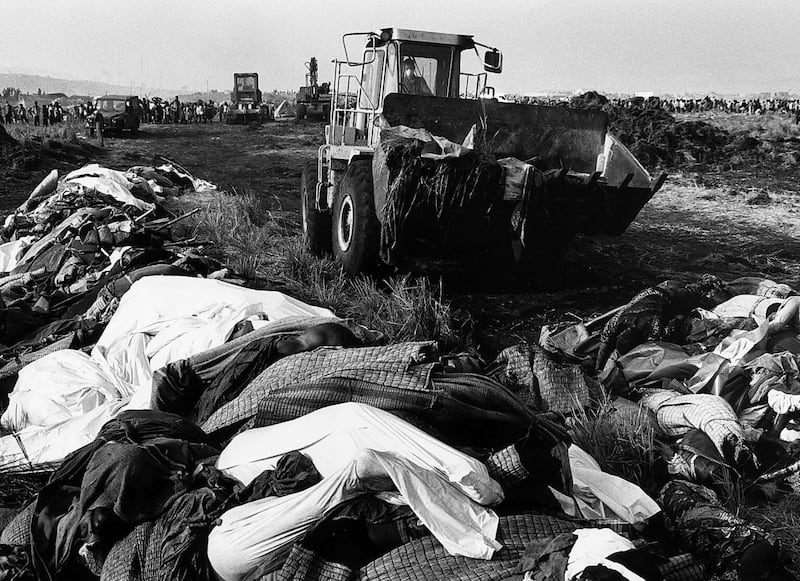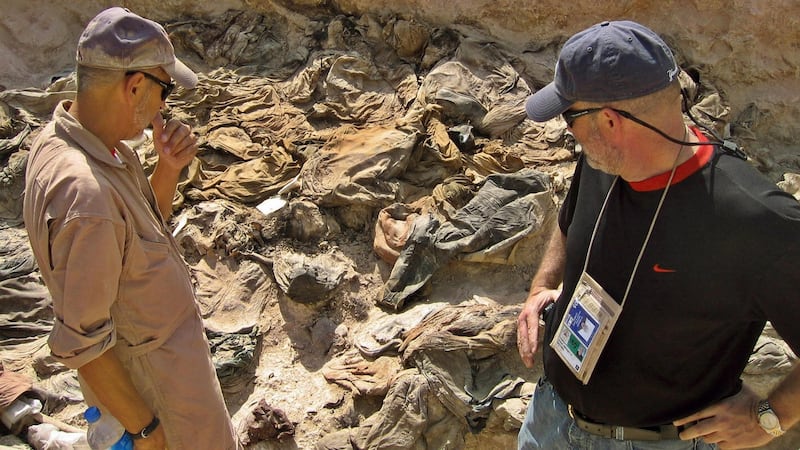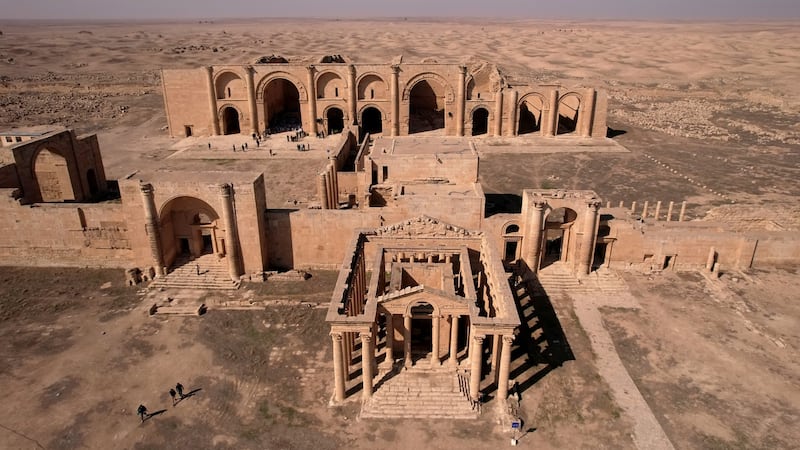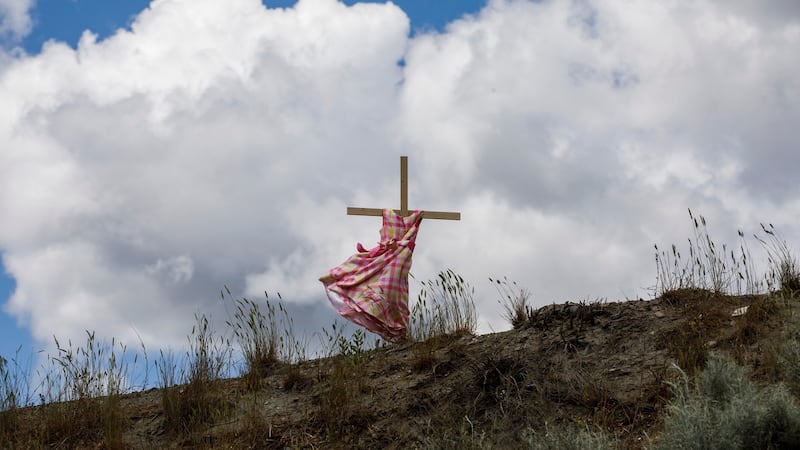A respected and well-loved musician, seemingly healthy and in early middle age, died unexpectedly last month at his home in Dublin. It was late in the evening, and his wife and children were sleeping upstairs. The coroner did an autopsy, but at time of writing they still don’t know why he died.
The service was held in a Unitarian church. If the Unitarians believe in one thing, it’s that they don’t believe in dogma, and the celebrant told the packed church, at the start of proceedings, that she did not know what, if anything, happens to us next. We are free to fill in the blanks for ourselves.
The dead man’s father-in-law, a noted physicist, told the packed congregation the same thing he had told his stunned grandchildren, a scientific truth, if such a thing exists. We are all made of energy, he said, of which matter is only a form, and when we die our energy passes into other states of being. But it cannot be destroyed. It will go on forever. The children found this comforting. The congregation clapped.
Most people have heard that, in theory, light can propagate forever through space and time (please, for now, let’s not tell the kids about Santa Claus, or the heat death of the universe), however diffused, reflected and refracted, unless something dark crosses its path. But so too, in theory, can sound. Even in deepest space, a type of sound persists: the vibration of atoms, agitated by the electric and gravitational fields of their neighbours, spreading outward from the initial shock. Except that the particles that float in deep space are much farther apart than those compressed in a planetary atmosphere, so the sound they conduct is vastly fainter, and travels much more slowly.
In theory, if you were able to travel fast enough and far enough out into space, and if you had a microphone that was sufficiently sensitive, and a means of filtering out all the background noise of the universe, you could lie in wait for the signals from our past. You could eavesdrop, for instance, on the first note ever played by that silenced musician, when he was a curious child, or to the Sermon on the Mount, or to the first word ever spoken in the first human language. A word like “Umm” or “Mum” most likely, the sound of a baby’s lips sleepily falling away from a breast, and therefore the name of the first and last goddess, the name that many people call out as they die. There may also be comfort in that.
Why do atheists bother with funerals? It makes sense to take pains to dispose of a corpse if you believe that the rites have actual meaning, that a correct form of disposal is a necessary step to some further end. Some religions hold, or at least suggest, that certain forms of burial, and associated prayers and rituals, are necessary for the deceased to attain an afterlife, or prosper therein. From this derives the almost universal human practice, going back tens of thousands of years, of leaving artifacts, tools, food or weapons in the graves of loved ones. From this, the various cultural taboos for and/or against interfering with corpses by mutilation, mummification, embalming, burning, disembowelment, exposure, ossification or cannibalism. From this, the scattering of ashes, the first handful of earth in an open grave.
How far back does this go? The great religions of the historic period – meaning, in practice, the period in which some people started writing things down – are mostly based on scripture, but these scriptures usually make little mention of many of the grave rites practised by their faithful – the pinch of earth, the placing of stones, the sprinkling of magic water. Some were probably already in use when the scriptures were written. They may well predate our species. Various animals, including chimpanzees, our nearest relatives, have been observed to gather around and mourn their dead. Dogs really do pine on the graves of dead masters, and elephants cover their dead with branches and grass. One female elephant was said to have left her herd every year to return alone to the place where her calf had died, at the same point in the season. In our house, we used to look after a friend’s Labrador, who had already lost a leg to the cancer that would kill her. Why should we assume that she did not, like a human, feel both the presence, and loss, of her phantom limb?

Almost 30 years ago, in an African country that was then called Zaire, a young reporter stumbled across a mass grave in progress. Local volunteers were burying truckloads of corpses, Rwandan refugees fallen victim to cholera, that were lining the roads in their thousands. The French army had provided a bulldozer to carve a trench in a banana grove, and a young soldier stood by with a walkie-talkie, to tell his comrade in the bulldozer when to fill it in. You could tell from his eyes, over his medical face mask, that this soldier was new at this. So was the reporter.
The volunteers tossed the bodies straight off the trucks into the trench. Apart from them, the soldier and the journalist were the only ones standing by the grave. The situation was plain, required no explanation, but reporters need quotes, and this one was holding a notebook. So he asked the young soldier, as a way to break what seemed to him like an awkward silence, if there was anyone there who would say something.
The soldier seemed puzzled. Maybe not puzzled. Maybe numbed is the word.
Say something?
Some words. For the dead. In the hole.
The reporter couldn’t think of the French word for “grave”.
No, said the soldier. He looked around him, as if checking the scene for himself. No, there was no one. He thought some more. There might be a priest in the town, he said, but if there was, he didn’t come out here.
Later, it occurred to the reporter that, having been raised as a Catholic, he was himself technically authorised, in extremis, faute de mieux, to say the prayers for the dead in place of a priest. Most of these dead Rwandans, statistically, would have been at least nominally Catholic too. As would the French soldier, more likely than not. But the reporter was agnostic. All he had was his notebook. As for the soldier, he had his own ministry to perform, with his walkie-talkie. So there were some words, sort of. Better than none.
In 2003, on the heels of the invasion of Iraq, a team of American forensic experts came to investigate the numerous massacres of civilians by Saddam Hussein’s deposed regime. In a dried river bed in the desert, on the ill-defined border between Iraq’s Kurdish north and the mainly Sunni Arab centre, they made the first excavation of what turned out to be a mass grave, concealing several thousand Kurdish civilians murdered by Saddam’s men in the late 1980s. The dead, mostly women and children, lay huddled together, babies in their mothers’ arms. Most appeared to have been shot at close range as they knelt in a trench.


Clawed back to the light by yet another army earth-mover, the remains of the first few victims, still wrapped in traditional bright Kurdish clothing, were treated with a reverence they’d been denied in their burial. The corpses – now dried bones and tufts of hair, weighing almost nothing – were cradled gently from the ground, tenderly laid on spread plastic groundsheets. Their bones would be sorted, the scientists said, and DNA would be taken, to put faces and names to the dead. In many cases, the job would be easy. So arrogant were the killers, and so lazy, that many victims were buried with their clothes and possessions, including identity cards, jewellery, letters. When this became known, desperate relatives would soon start coming to this site, and to others like it, to dig up the ground for themselves, hoping to find their own missing loved ones. Across Iraq, as many as 300,000 people vanished into such graves.
Among those present at the graveside that day was the aforementioned reporter, now nine years older and somewhat more hardened. Almost blasé, you might say. As the digging went on, his attention wandered to a clump of spectacular stone ruins – rows of Greek-style columns and pediments, of temples and palaces, statues and friezes – that rose from the desert just to the north. None of the local Iraqi drivers, translators, and helpers seemed to know, or care, who had built them, and when, though one Kurdish fixer had a tentative name for them. Hatar, he thought, or something like that.
When his notebook had enough words in it, the reporter left the grave to go look at the ruins. Drawing closer, he saw a Stars and Stripes flying from the ceremonial gate, and a Humvee parked beneath it. From a sandbagged position on top of the high arch, US soldiers watched through binoculars as his car drove up, and two of them came down to talk to him. The Americans were friendly, but clearly very bored, and vague about their mission, as if they weren’t really sure of it themselves. We were told to watch the desert, one said. There’s a good view of it from here.
How long had they been stationed in these ruins?
A few weeks now. Since the invasion.
So what was this place, exactly? All these temples and statues of kings and of gods?
The two soldiers looked at each other, puzzled, not for lack of an answer, but at the question itself. We call this “The Old Ruins,” one of them said.
The reporter looked it up later, online. The city of Hatra, built two thousand years ago, was a renowned centre of religion and trade at a crossroads in the desert, guarded by two kilometres of wall and towers, a cultural melting pot between the civilisations of Persia, Arabia, Mesopotamia and the Greco-Roman world. Its temples and statues and tombs and friezes, many surviving intact to this day, still proclaim its rulers’ wealth and power, in this world and the next. But you never hear about it, do you? It’s not exactly Nineveh, or Babylon, or Rome.
And did any of the grieving Kurds who flocked here, when news of the mass grave leaked out, give any more thought than those bored Americans, the latest in so many waves of invaders, to what, exactly, “The Old Ruins” were, and what names they used to go by? The only history they cared about was buried, not very deep, just under their feet in the bed of a dry river.

The summer of 2021 was a horrific one at a First Nation near Kamloops, British Columbia, where the remains of dozens of children were found in unmarked graves near the former residential school. Lights, stuffed toys and a child’s dress on a cross were put up to commemorate the dead.
The oldest signs of ritual practice, archaeologists say, relate to the laying to rest of the dead. In western Europe, where religious observance is in steep decline, many lapsed Christians still cling to their churches for weddings and funerals – particularly the funerals. If this trend continues, the earliest known religious rite will also be the last.
You’d think, then, that the big religions would be careful with the dead, to maintain their brand. But this hasn’t always been the case. The churches that lay Canadians to dignified rest in cemeteries and crematoria also disposed of thousands of Indigenous children in unmarked graves at state-funded residential schools. In Tuam, Co Galway, a recent investigation found “significant quantities” of remains of dead children in a former sewage tank in the grounds of a “mother and baby” home – one of 18 where Catholic nuns confined unmarried pregnant women until they gave birth and had their babies taken from them, if the babies survived the abysmal conditions. A local historian discovered that 796 death certificates had been issued for children at this home, but there had been only two registered burials. That sewage tank has yet to be forensically examined.

You don’t have to be religious, or related to the dead, or looking for a stick to beat the church or the government, to be moved by the thought of lives snuffed out, alone and unmourned, in the dark and the cold. Yet, in one sense, this is only a blunt statement of our general condition. All of us will die. All inscriptions wear away. All graves are nameless in the end, or if not nameless, faceless. Who was Cheops, really? What kind of a guy? All urns will be broken, all ashes lost. How far can you climb up your family tree, with your DNA tests and your genealogical searches, before the dead names overwhelm you? Let it go.
But we don’t. Not entirely. All round the world, folklores are full of the same warnings: do right by them, or they will haunt you. The hungry grass. The grateful dead. Restless ghosts, pacing cellars where walled-up bones will be found. The dead must be spoken for here, where their stories once had other possible endings, because they never knew for sure what their own ending was. Death is the one certainty, after birth, and it’s the only major life event that we can never look back on ourselves, or talk about to others. Death is not an event in life, Wittgenstein said, but it is for the survivors. It’s up to the living to talk for the dead, to finish their stories, then let them slip away.
The first echo is always the loudest. So we say our big goodbye at the grave side, or the crematorium, and let the universe take it from there. There's no way to track that energy's flight. But there is something eternal in what we say and feel for them. Everyone who was here, will always have been here. Everyone who was loved will have been loved forever. There is permanence in that, a ghost in the grammar.
Ed O'Loughlin is an Irish-Canadian author and journalist. He is the author of four novels and the new memoir The Last Good Funeral of the Year. This article was first publishe din the Toronto Globe & Mail











